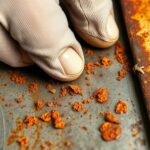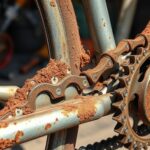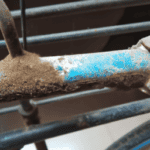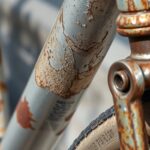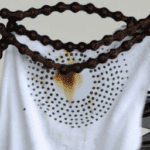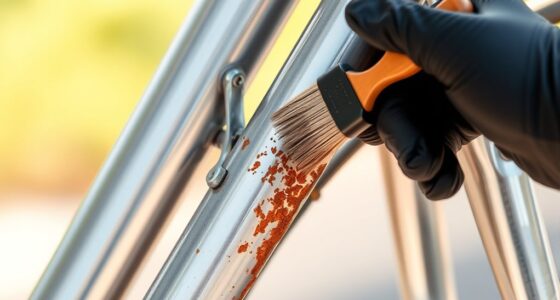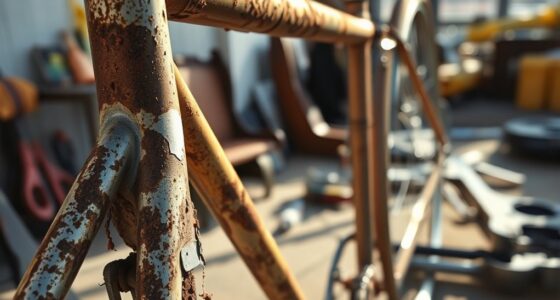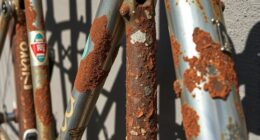When you spot rust on a metal surface, look closely for signs of structural damage like holes, cracks, or weakened areas underneath the rust. Check joints, welds, and supports for looseness or corrosion, as hidden rust can cause significant harm. Use tools to probe beneath paint and feel for soft spots. Addressing rust early helps prevent costly failures, so keep exploring to stay ahead of hidden dangers lurking beneath the surface.
Key Takeaways
- Conduct thorough visual inspections focusing on joints, welds, and supports for any cracks, holes, or deformations indicating structural issues.
- Use probing tools like screwdrivers to detect soft spots or hidden rust beneath paint layers that may compromise metal integrity.
- Look for signs of rust-induced expansion, such as bulging or warping of metal surfaces, which can signal underlying structural damage.
- Monitor areas with bubbling or blistering paint, as these often conceal rust and potential structural weakening behind coatings.
- Consider professional assessments, including non-destructive testing methods like ultrasonic or radiographic scans, to identify hidden structural damage.

Rust can silently undermine the integrity of metal structures, often going unnoticed until significant damage occurs. When corrosion begins to set in, it doesn’t usually announce itself with obvious signs. Instead, it slowly eats away at the metal, weakening beams, supports, and other essential components. That’s why spotting rust early is critical for effective corrosion prevention. The moment you notice any discoloration or rough patches, it’s time to take action before the problem worsens. Rust treatment options are available to halt the progression of corrosion and restore the strength of your structures, but prevention remains the best approach.
To spot structural damage under rust, you need to be vigilant. Regular inspections are your first line of defense. Carefully examine exposed metal surfaces for telltale signs like flaking paint, bubbling, or a reddish-brown hue. These are often the first indicators of rust forming beneath the surface. In more severe cases, you might notice holes or cracks developing, which can compromise the entire structure’s stability. Pay special attention to joints, welds, and areas exposed to moisture or harsh weather, as these spots are particularly susceptible to corrosion. Remember that rust can be hidden beneath layers of paint or protective coatings, so probing beneath the surface with a screwdriver or wire brush can reveal underlying damage. Being aware of early signs of rust can make a significant difference in timely intervention.
Addressing rust as soon as you detect it is essential. Incorporate rust treatment techniques that remove corrosion and prevent it from reappearing. Mechanical methods like wire brushing or sanding can strip away loose rust and reveal the clean metal underneath. For more extensive damage, chemical rust removers or rust converters can neutralize corrosion and create a protective barrier. Once the rust is treated, applying corrosion prevention coatings, such as rust-inhibiting primers and paints, helps safeguard the metal from future moisture exposure. These steps are indispensable for extending the life of your structures and avoiding costly repairs down the line.
Prevention is always better than cure. Regular maintenance routines that include inspections and protective coatings greatly reduce the risk of rust developing into serious structural issues. If you notice early signs of rust, don’t delay rust treatment—address it promptly to stop the damage from spreading. By staying vigilant and taking proactive measures, you preserve the integrity of your metal structures, ensuring they remain safe and durable for years to come. Remember, catching rust early and implementing effective corrosion prevention strategies saves you time, money, and trouble in the long run.
Frequently Asked Questions
How Can I Prevent Rust From Forming on Structural Components?
To prevent rust from forming on structural components, you should apply protective coatings like paint or sealants that create a barrier against moisture. Using metal treatments such as rust inhibitors or galvanization can also help. Regularly inspect and maintain these surfaces, reapplying coatings as needed. Keeping the environment dry and minimizing exposure to water and humidity will further protect your structures from rust and corrosion over time.
What Are the Early Signs of Rust-Induced Structural Damage?
You’ll notice early signs of rust-induced structural damage through corrosion indicators like flaky, bubbling paint or discoloration on metal surfaces. Metal fatigue may cause cracks or warping, especially near rusted areas. Keep an eye out for soft spots or areas that feel brittle when tapped. These signs suggest rust has compromised your structure’s integrity, so inspecting and addressing them promptly can prevent serious damage and guarantee safety.
Are There Specific Environments That Accelerate Rust Damage?
Corrosive environments, like those with high humidity, saltwater, or industrial pollutants, accelerate rust damage markedly. You should be especially cautious if your structures are exposed to these conditions, as they weaken metal faster. Applying protective coatings can help, but if the environment remains corrosive, these coatings may wear down quickly. Regular inspections and maintenance are essential to prevent severe rust-related structural issues in such harsh settings.
How Often Should I Inspect Rust-Prone Structures?
Think of your rust-prone structures as a garden needing regular watering. You should inspect them at least every 6 to 12 months. During inspections, look for signs of rust or corrosion. Applying paint protection and corrosion inhibitors acts like a shield, slowing rust’s advance. Regular checks help catch issues early, preventing costly repairs. Keep an eye on weather conditions, especially in humid environments, to maintain the structure’s strength.
Can Rust Damage Be Repaired Without Total Replacement?
Yes, rust damage can often be repaired without total replacement. You should start with rust treatment to remove rust and halt further corrosion. Then, consider structural reinforcement to strengthen the affected area. This approach restores the integrity of your structure cost-effectively. Regular inspections and timely repairs help prevent extensive damage, saving you money and effort in the long run. Always consult a professional for a thorough assessment and proper repair techniques.
Conclusion
Just like a hidden storm can weaken a sturdy tree from within, rust silently eats away at your structure’s integrity. By spotting and addressing rust early, you prevent small cracks from turning into catastrophic failures. Think of rust as a slow, creeping tide—once it reaches a critical point, it can flood your safety. Stay vigilant and proactive; catching rust before it spreads keeps your structure strong and standing firm against the test of time.


